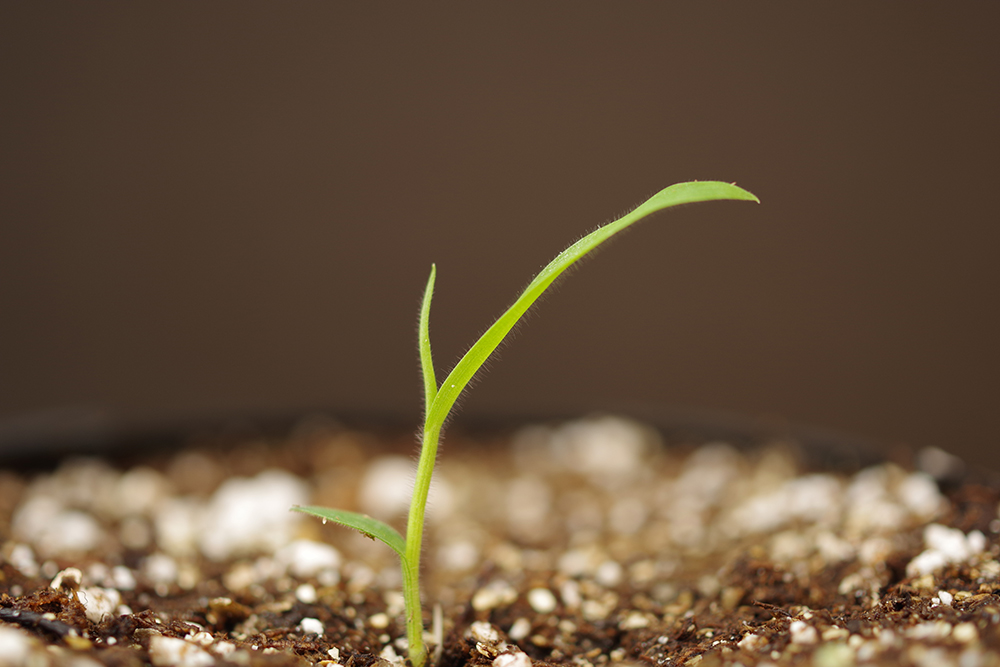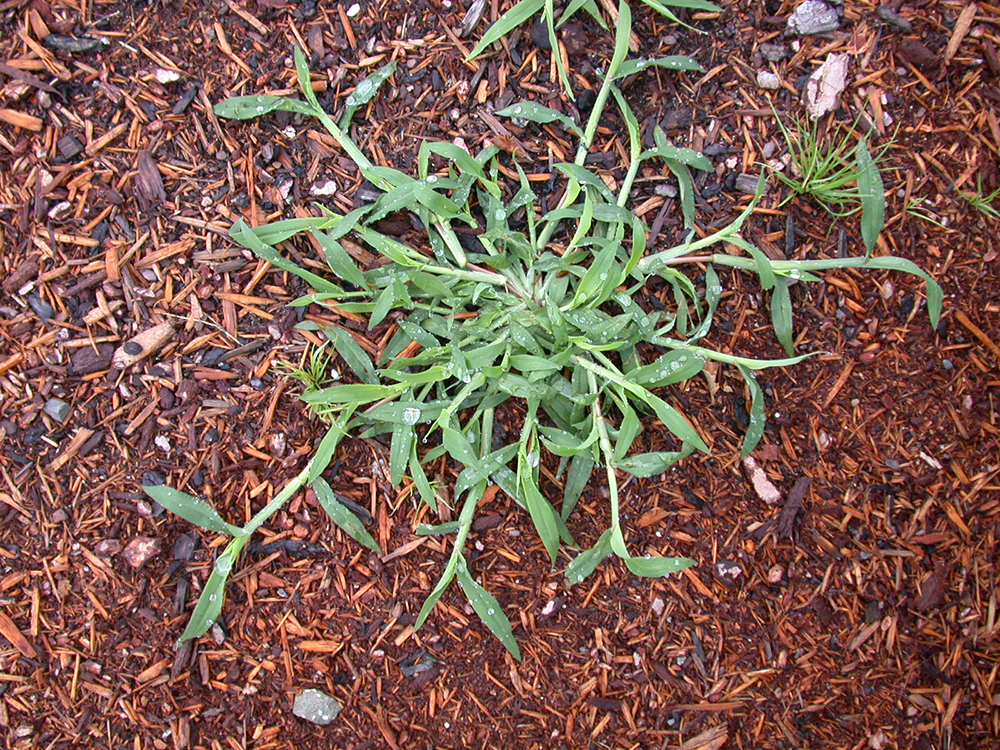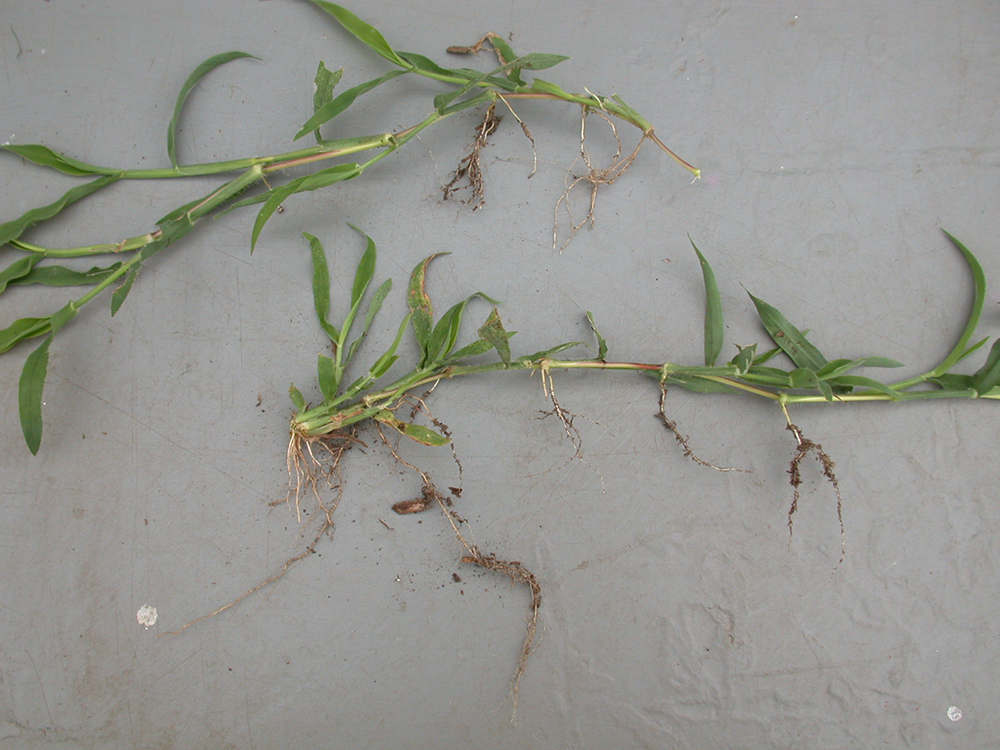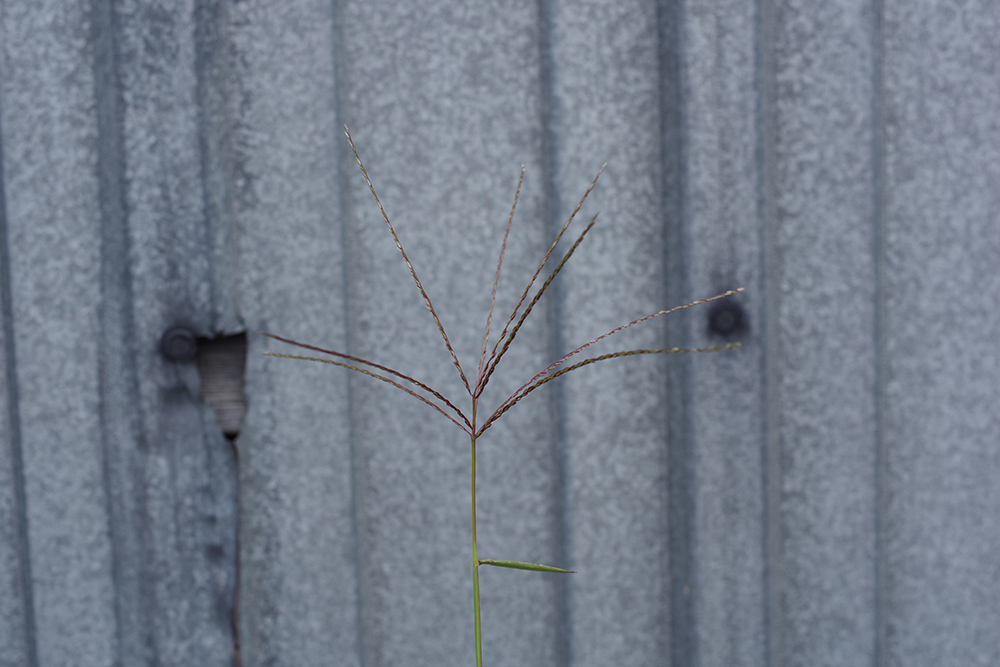Other common names: purple crab grass, finger grass, Polish millet, crowfoot grass, pigeon grass, hairy crabgrass, hairy finger grass, northern crabgrass



rooting at stem nodes

Digitaria sanguinalis (L.) Scop.
Identification of Large Crabgrass
Family: Grass family, Poaceae
Habit: Sprawling summer annual grass with stems rooting at the nodes
Description: Seedlings have an upright habit and begin tillering when they have only four to five true leaves. Seed leaves are parallel to the ground, oval to elongated in shape (only three to four times longer than wide) and rounded at the tip. True leaves are rolled in the bud and uncurl as they emerge. Ligules are membranous, translucent and jagged. Auricles are absent. Collars are broad with hairy edges. Blades are linear, 2–4.75 inches long by 0.1–0.2 inch wide and tapered to a point. Stiff, erect hairs are present on both blade surfaces and on the sheath. Mature plants have dozens of tillers; stems are 12–48 inches with erect central stems and sprawling outer stems that root at the nodes. Mature stems are flattened and red at the base. Sheaths are compressed, hairy and closed. Leaves are similar to young seedling leaves, but blades are up to 8 inches long by 0.6 inch wide. Fibrous roots extend up to 6.5 feet deep. Inflorescences are terminal, composed of up to 13 (usually three to five) flat, fingerlike spikes arranged in a spiral near the stem tip. Two rows of 0.1 inch spikelets are arranged alternately along each spike. Seeds are glossy, yellow-brown, elliptical or lanceolate.
Similar species: Smooth crabgrass (Digitaria ischaemum (Schreb.) Schreb. ex Muhl.) is closely related and has a non-jagged, translucent ligule and few hairs on leaf blades or sheaths. Goosegrass (Eleusine indica (L.) Gaertn.) is also mat-forming, but goosegrass leaves are folded in the bud. Southern crabgrass (Digitaria ciliaris (Retz.) Koeler) has hairs on the sheaths but none on the blades. Yellow foxtail (Setaria pumila (Poir.) Roem. & Schult.) and witchgrass (Panicum capillare L.) seedlings are also rolled in the bud and lack auricles, but they have a hairy ligule.
Management of Large Crabgrass
The tiny, fragile seedlings of large crabgrass are easily killed by tine weeding or rotary hoeing just before or shortly after they emerge. Once the seedlings have developed roots at the base of the shoot in addition to the primary root from the seed, they are harder to kill. Early planted corn may grow too large for in-row weed management when most crabgrass emerge. In crops that tolerate hilling-up, try to do so before the first true leaf elongates since an incompletely buried plant can recover. When cultivating to kill larger plants, set up cultivators to cut flat and shallow so that the shoots quickly dry on the soil surface. Burying the plants is less effective because complete burial of larger plants is nearly impossible, and large crabgrass reroots exceptionally well.
Since most large crabgrass seeds do not persist long in the soil, rotation into a sod crop for a few years greatly decreases the seed bank, provided seed production is prevented during establishment of the sod. Cutting sod as high as possible will facilitate competitive suppression of crabgrass by these crops, including turfgrass. The prostrate growth habit and tolerance of hot, dry summer conditions make this species well-suited to gaps in regularly mowed hay crops, so good hay stands are essential during the hay phase of rotations. Vegetable rotations that include early, short-season crops tend to reduce the population by allowing many seedlings to emerge shortly before harvest. Subsequent tillage for the next crop or cover crop then destroys the young crabgrass before they can set seeds. A tilled fallow period during the first four to six weeks of warm weather can effectively decrease severe infestations since most seeds will germinate if provided with warm, moist conditions.
Straw mulch applied in the spring keeps the soil too cool for germination and is highly effective. The same mulch material applied after the soil warms will be relatively ineffective because large crabgrass seedlings can worm up through at least 3 inches of straw. Green manure cover crops in the mustard family incorporated in the spring provided 48–79% control of large crabgrass at four weeks after transplanting bell peppers in South Carolina, but no control was detected later in the season.
Ecology of Large Crabgrass
Origin and distribution: Large crabgrass probably originated in Asia or Africa and was introduced into North America during European settlement. It occurs in both temperate and tropical climates, and is currently distributed from 50° N latitude to 40° S latitude around the world.
Seed weight: 0.46–0.59 mg
Dormancy and germination: Seeds are dormant when shed from the parent plant, but they gradually lose dormancy over a period of several months. Cold treatment accelerates the loss of dormancy, as does puncturing or damaging the seed coat. Daily alternating temperatures between 68°F and 86°F maximize germination. Light is not essential, but it can enhance germination. Nitrate modestly increased laboratory germination and field emergence of fresh (dormant) seeds, but otherwise had no effect on germination or emergence of after-ripened seeds. Seeds undergo a periodic annual cycle in soil whereby dormancy is low in spring following cold after-ripening, and secondary dormancy is induced in mid-summer when temperatures exceed 81–86°F.
Seed longevity: No seeds survived longer than three years when buried at 1.7 inch under turfgrass, but approximately 55% survived for one year. The annual mortality rate of large crabgrass seeds buried in an agricultural field was computed to be 54%. Seed survival is probably poorer in tilled soil.
Season of emergence: In Canada, large crabgrass emerged primarily in June and July. In Ohio and the Mid-Atlantic area, most seedlings emerged in May and June, with some emergence continuing through the growing season. In warm climates such as Florida, soil tillage in February to April led to maximum establishment. In all cases, these emergence periods generally follow the last frost for the respective area. Emergence occurs when rainfall exceeds 0.2 inches of rain and when soil temperature exceeds 50–58°F.
Emergence depth: Large crabgrass emerges best within the top 0.8 inch, with some emergence from as deep as 3 inches.
Photosynthetic pathway: C4
Sensitivity to frost: Large crabgrass is frost sensitive.
Drought tolerance: Large crabgrass grows best at high temperatures and thrives in conditions that cause heat or moisture stress in many other plant species. It develops a disproportionally larger root system very quickly, which enhances its ability to compete with neighboring species. The roots penetrate to 6 feet, which allows the plants to tap residual soil moisture that is unavailable to many crops.
Mycorrhiza: Large crabgrass has mycorrhizae.
Response to fertility: Large crabgrass tolerates infertile soils, but it is highly responsive to fertility, both when growing alone and in competition with a crop. It is a strong concentrator of most major nutrients but particularly K, which may reach more than 6% of foliage dry weight. Nevertheless, strong competition from corn prevented a response to nutrient rate in one experiment. It tolerates low pH soil, with maximum emergence and growth at pH 4.8–5.8. Magnesium carbonate was more effective than calcium carbonate at reducing emergence and growth of large crabgrass when raising soil pH to neutral levels.
Soil physical requirements: Large crabgrass tolerates a wide range of soil conditions.
Response to shade: Large crabgrass is partially shade tolerant. In field conditions it has been found to tolerate up to 63% shade without reduction in productivity or seed set. Greater degrees of shade, however, greatly reduce growth.
Sensitivity to disturbance: Seedlings are tiny and easily damaged. Completely uprooting larger plants is difficult due to the extensive, fibrous root system. Medium to large plants reroot readily in moist soil. Like all grasses, the growing points are near the soil surface, so simply slicing off the plant at ground level will result in vigorous resprouting. Covering the lower portion of stems with soil during cultivation or hoeing promotes rooting of the stems at the nodes.
Time from emergence to reproduction: Large crabgrass generally flowers from July to September. Plants that emerged in May first flowered in July, about 10 weeks after emergence, whereas plants that emerged in June flowered eight weeks after emergence.
Pollination: Large crabgrass is primarily self pollinated, but it sometimes cross pollinates by wind.
Reproduction: Reproduction is principally from seeds, but large crabgrass is one of the few annual weeds that also can reproduce vegetatively. The outer stems of the plant lie on the ground and tend to form roots where the nodes (especially the first node) come into contact with the soil. Consequently, single plants up to 10 feet in diameter have been observed. The species flowers in response to short day length. Once a plant begins to flower, it will continue to flower and set seed until frost. Well-spaced plants emerging in May in Connecticut produced an average of 145,000 seeds per plant, but seed production at high plant densities range from 100–6,800 seeds per plant.
Dispersal: Large crabgrass seeds have no apparent adaptations for dispersal. However, because they often reach high densities in soil, they are easily spread from one site to another in soil clinging to tires and machinery. Seeds also disperse in irrigation water. The species is common on waste areas and in lawns, and it frequently has to travel only short distances to invade a field.
Common natural enemies: Larvae of the flea beetle, Chaetocnema denticulate, bore into the top of the seed head while it is in the boot stage and feed on the stems and immature seeds. In Virginia, 26% of seed heads were infested, and the insect completed three generations per year. Various species of Oscinella fruit fly larvae mine the stems. Loose smut (Ustilago syntherismae) can significantly reduce the proportion of reproductive plants. Drechslera gigantea leaf spot can cause significant injury and has been explored as a bioherbicide.
Palatability: The seeds are edible and can be ground for flour or cooked as porridge. The species is excellent cattle fodder and is sometimes harvested for hay.
Summary Table of Large Crabgrass Characteristics
| Large crabgrass | ||||||||
|---|---|---|---|---|---|---|---|---|
| Growth habit | Seed weight (mg) | Seed dormancy at shedding | Factors breaking dormancy | Optimum temperature for germination (F) | Seed mortality in untilled soil (%/year) | Seed mortality in tilled soil (%/year) | Typical emergence season | Optimum emergence depth (inches) |
| prostrate | 0.46–0.59 | Yes | cms, at | 68–86 | 45–54 | na | spring | 0–0.8 |
| Photosynthesis type | Frost tolerance | Drought tolerance | Mycorrhiza | Response to nutrients | Emergence to flowering (weeks) | Flowering to viable seed (weeks) | Pollination | Typical & high seed production (seeds per plant) |
| C4 | low | high | yes | high | 8–10 | – | self, can cross | 1,000 & 145,000 |
Table Key
General: The designation “–” signifies that data is not available or the category is not applicable.
Growth habit: A two-word description; the first word indicates relative height (tall, medium, short, prostrate) and second word indicates degree of branching (erect, branching, vining).
Seed weight: Range of reported values in units of “mg per seed.”
Seed dormancy at shedding: “Yes” if most seeds are dormant when shed, “Variable” if dormancy is highly variable, “No” if most seeds are not dormant.
Factors breaking dormancy: The principle factors that are reported to break dormancy and facilitate germination. The order of listing does not imply order of importance. Abbreviations are:
scd = seed coat deterioration
cms = a period subjected to cold, moist soil conditions
wst = warm soil temperatures
li = light
at = alternating day-night temperatures
ni = nitrates
Optimum temperature range for germination: Temperature (Fahrenheit) range that provides for optimum germination of non-dormant seeds. Germination at lower percentages can occur outside of this range. The dash refers to temperature range, and the slash refers to alternating day/night temperature amplitudes.
Seed mortality in untilled soil: Range of mortality estimates (percentage of seed mortality in one year) for buried seeds in untilled soil. Values were chosen where possible for seeds placed at depths below the emergence depth for the species and left undisturbed until assessment. Mortality primarily represents seed deterioration in soil.
Seed mortality in tilled soil: Range of mortality estimates (percentage of seed mortality in one year) for seeds in tilled soil. Values were chosen for seeds placed within the tillage depth and subjected to at least annual tillage events. Seed losses are the result of dormancy-breaking cues induced by tillage, germination and deterioration of un-germinated seeds.
Typical emergence season: Time of year when most emergence occurs in the typical regions of occurrence for each weed. Some emergence may occur outside of this range.
Optimum emergence depth: Soil depths (in inches below the soil surface) from which most seedlings emerge. Lower rates of emergence usually will occur at depths just above or just below this range.
Photosynthesis type: Codes “C3” or “C4” refer to the metabolic pathway for fixing carbon dioxide during photosynthesis. Generally, C3 plants function better in cooler seasons or environments and C4 plants function better in warmer seasons or environments.
Frost tolerance: Relative tolerance of plants to freezing temperatures (high, moderate, low).
Drought tolerance: Relative tolerance of plants to drought (high, moderate, low).
Mycorrhiza: Presence of mycorrhizal fungi. “Yes” if present; “no” if documented not to be present, “unclear” if there are reports of both presence and absence; “variable” if the weed can function either with or without, depending on the soil environment.
Response to nutrients: Relative plant growth response to the nutrient content of soil, primarily N, P, K (high, moderate, low).
Emergence to flowering: Length of time (weeks) after emergence for plants to begin flowering given typical emergence in the region of occurrence. For species emerging in fall, “emergence to flowering” means time from resumption of growth in spring to first flowering.
Flowering to viable seed: Length of time (weeks) after flowering for seeds to become viable.
Pollination: “Self” refers to species that exclusively self-pollinate, “cross” refers to species that exclusively cross-pollinate, “self, can cross” refer to species that primarily self-pollinate, but also cross-pollinate at a low rate, and “both” refers to species that both self-pollinate and cross-pollinate at relatively similar rates.
Typical and high seed production potential: The first value is seed production (seeds per plant) under typical conditions with crop and weed competition. The second value, high seed production, refers to conditions of low density without crop competition. Numbers are rounded off to a magnitude that is representative of often highly variable reported values.
Further Reading
Gallart, M., M.T. Ma and A.M.C. Verdú. 2010. Demography of Digitaria sanguinalis: Effect of the emergence time on survival, reproduction, and biomass. Weed Biology and Management 10: 132–140.
Holm, L.G., D.L. Plucknett, J.V. Pancho and J.P. Herberger. 1977. The World's Worst Weeds: Distribution and Biology. University Press of Hawaii: Honolulu.
Peters, R.A. and S. Dunn. 1971. Life history studies as related to weed control in the Northeast. 6 – Large and small crabgrass. Storrs Agricultural Experiment Station, The University of Connecticut: Storrs, CT.

